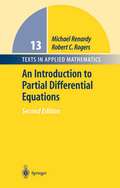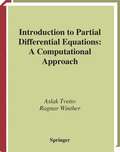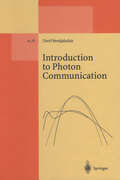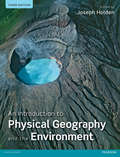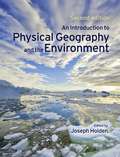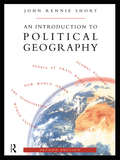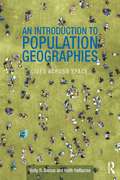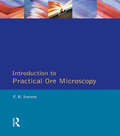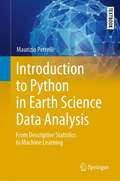- Table View
- List View
Introduction to Organic Geochemistry
by Stephen D. Killops Vanessa J. KillopsAn Introduction to Organic Geochemistry explores the fate of organic matter of all types, biogenic and man-made, in the Earth System. investigates the variety of pathways and biogeochemical transformations that carbon compounds can experience over a range of time scales and in different environments scope widened to provide a broad and up-to-date background - structured to accommodate readers with varied scientific backgrounds essential terminology is defined fully and boxes are used to explain concepts introduced from other disciplines further study aided by the incorporation of carefully selected literature references It investigates the variety of pathways and biogeochemical transformations that carbon compounds can experience over a range of time scales and in different environments.
Introduction to Organic Geochemistry
by Stephen D. Killops Vanessa J. KillopsAn Introduction to Organic Geochemistry explores the fate of organic matter of all types, biogenic and man-made, in the Earth System. investigates the variety of pathways and biogeochemical transformations that carbon compounds can experience over a range of time scales and in different environments scope widened to provide a broad and up-to-date background - structured to accommodate readers with varied scientific backgrounds essential terminology is defined fully and boxes are used to explain concepts introduced from other disciplines further study aided by the incorporation of carefully selected literature references It investigates the variety of pathways and biogeochemical transformations that carbon compounds can experience over a range of time scales and in different environments.
Introduction to Paleobiology and the Fossil Record
by Michael J. Benton David A. HarperThis book presents a comprehensive overview of the science of the history of life. Paleobiologists bring many analytical tools to bear in interpreting the fossil record and the book introduces the latest techniques, from multivariate investigations of biogeography and biostratigraphy to engineering analysis of dinosaur skulls, and from homeobox genes to cladistics. All the well-known fossil groups are included, including microfossils and invertebrates, but an important feature is the thorough coverage of plants, vertebrates and trace fossils together with discussion of the origins of both life and the metazoans. All key related subjects are introduced, such as systematics, ecology, evolution and development, stratigraphy and their roles in understanding where life came from and how it evolved and diversified. Unique features of the book are the numerous case studies from current research that lead students to the primary literature, analytical and mathematical explanations and tools, together with associated problem sets and practical schedules for instructors and students. “..any serious student of geology who does not pick this book off the shelf will be putting themselves at a huge disadvantage. The material may be complex, but the text is extremely accessible and well organized, and the book ought to be essential reading for palaeontologists at undergraduate, postgraduate and more advanced levels—both in Britain as well as in North America.” Falcon-Lang, H., Proc. Geol. Assoc. 2010 “…this is an excellent introduction to palaeontology in general. It is well structured, accessibly written and pleasantly informative …..I would recommend this as a standard reference text to all my students without hesitation.” David Norman Geol Mag 2010 Companion website This book includes a companion website at: www.blackwellpublishing.com/paleobiology The website includes: · An ongoing database of additional Practical’s prepared by the authors · Figures from the text for downloading · Useful links for each chapter · Updates from the authors
An Introduction to Partial Differential Equations (Texts in Applied Mathematics #13)
by Michael Renardy Robert C. RogersPartial differential equations are fundamental to the modeling of natural phenomena. The desire to understand the solutions of these equations has always had a prominent place in the efforts of mathematicians and has inspired such diverse fields as complex function theory, functional analysis, and algebraic topology. This book, meant for a beginning graduate audience, provides a thorough introduction to partial differential equations.
Introduction to Partial Differential Equations: A Computational Approach (Texts in Applied Mathematics #29)
by Aslak Tveito Ragnar WintherCombining both the classical theory and numerical techniques for partial differential equations, this thoroughly modern approach shows the significance of computations in PDEs and illustrates the strong interaction between mathematical theory and the development of numerical methods. Great care has been taken throughout the book to seek a sound balance between these techniques. The authors present the material at an easy pace and exercises ranging from the straightforward to the challenging have been included. In addition there are some "projects" suggested, either to refresh the students memory of results needed in this course, or to extend the theories developed in the text. Suitable for undergraduate and graduate students in mathematics and engineering.
Introduction to Permanent Plug and Abandonment of Wells (Ocean Engineering & Oceanography #12)
by Mahmoud Khalifeh Arild SaasenThis open access book offers a timely guide to challenges and current practices to permanently plug and abandon hydrocarbon wells. With a focus on offshore North Sea, it analyzes the process of plug and abandonment of hydrocarbon wells through the establishment of permanent well barriers. It provides the reader with extensive knowledge on the type of barriers, their functioning and verification. It then discusses plug and abandonment methodologies, analyzing different types of permanent plugging materials. Last, it describes some tests for verifying the integrity and functionality of installed permanent barriers. The book offers a comprehensive reference guide to well plugging and abandonment (P&A) and well integrity testing. The book also presents new technologies that have been proposed to be used in plugging and abandoning of wells, which might be game-changing technologies, but they are still in laboratory or testing level. Given its scope, it addresses students and researchers in both academia and industry. It also provides information for engineers who work in petroleum industry and should be familiarized with P&A of hydrocarbon wells to reduce the time of P&A by considering it during well planning and construction.
Introduction to Perturbation Techniques
by Ali H. NayfehSimilarities, differences, advantages and limitations of perturbation techniques are pointed out concisely. The techniques are described by means of examples that consist mainly of algebraic and ordinary differential equations. Each chapter contains a number of exercises.
Introduction to Photon Communication (Lecture Notes in Physics Monographs #29)
by Cherif BendjaballahIn recent years, progress in the generation of squeezed states of light, mainly characterized by a reduced noise property, has stimulated important work in relation to their potential use to improve the sensitivity of optical communication systems. These notes are devoted to the detection and information processing of optical signals at very low levels of power. A survey of recent developments from the quantum and classical points of view is presented. Ultimate limits of performance under the criteria of detection and information are established. Some of the results are detailed and may be utilized for the design of practical systems of communication using present technology. The book addresses physicists and engineers interested in present and future developments in optical communications.
An Introduction to Physical Geography and the Environment
by Prof Joseph HoldenThis highly respected and best-selling textbook provides an engaging and comprehensive introduction to the major topics within physical geography. It focuses on understanding the inter-linkages between processes, places and environments and is fully illustrated to demonstrate how the physical environment works. An Introduction to Physical Geography and the Environment is accompanied by a rich and extensive range of electronic support resources including updated weblinks relevant for each chapter, multiple choice questions, fieldwork exercises, interactive models and video clips.The text is suitable for both undergraduate and postgraduate study in the field of physical geography.
An Introduction To Physical Geography And The Environment (PDF)
by Joseph HoldenAn introduction to the major subjects of physical geography, this volume seeks to offer a baseline understanding of the environmental forces that have shaped, & continue to shape, the world in which we live. Each chapter is written by an expert in the given field.
An Introduction to Physical Geography and the Environment (PDF)
by Prof Joseph HoldenThis highly respected and best-selling textbook provides an engaging and comprehensive introduction to the major topics within physical geography. It focuses on understanding the inter-linkages between processes, places and environments and is fully illustrated to demonstrate how the physical environment works. An Introduction to Physical Geography and the Environment is accompanied by a rich and extensive range of electronic support resources including updated weblinks relevant for each chapter, multiple choice questions, fieldwork exercises, interactive models and video clips.The text is suitable for both undergraduate and postgraduate study in the field of physical geography.
Introduction to Phytoremediation of Contaminated Groundwater: Historical Foundation, Hydrologic Control, and Contaminant Remediation
by James E. LandmeyerThis book provides the reader with the comprehensive view necessary to understand and critically evaluate the design, implementation, and monitoring of phytoremediation at sites characterized by contaminated groundwater. Part I presents the historical foundation of the interaction between plants and groundwater, introduces fundamental groundwater concepts for plant physiologists, and introduces basic plant physiology for hydrogeologists. Part II presents information on how to assess, design, implement, and monitor phytoremediation projects for hydrologic control. Part III presents how plants take up and detoxify a wide range of organic xenobiotics in contaminated groundwater systems, and provides various approaches on how this can be assessed and monitored. Throughout, concepts are emphasized with numerous case studies, illustrations and pertinent literature citations.
An Introduction to Place-Based Development Economics and Policy
by Gilberto SeravalliThis book introduces the reader to local development economics and policy, with a special focus on the place-based paradigm that covers its justification, its difficulties and the types of public intervention that it suggests. The starting point for the analysis is that economic development in lagging places is not to be expected as the result of a mechanism of automatic convergence between backward and advanced regions and that, therefore, the most appropriate development policy is not to maximize competition among all agents in all sectors and places. The failure of the Washington Consensus is examined, and the two competing positions to have emerged from this failure – spatially blind interventions and place-based policies – are contrasted. The main shortcoming of spatially blind policies, namely that immobile resources that could trigger or support a development process often remain untapped or “trapped”, is emphasized. The limitations of the “big push” state intervention and wage flexibility solutions to this trap are analyzed and the merits of place-based policies that support intervention and can deal with uncertainty, risk and conflict are discussed.
An Introduction to Planetary Atmospheres
by Agustin Sanchez-LavegaPlanetary atmospheres is a relatively new, interdisciplinary subject that incorporates various areas of the physical and chemical sciences, including geophysics, geophysical fluid dynamics, atmospheric science, astronomy, and astrophysics. Providing a much-needed resource for this cross-disciplinary field, An Introduction to Planetary Atmospheres p
Introduction to Planetary Science: The Geological Perspective
by Gunter Faure Teresa M. MensingThis textbook details basic principles of planetary science that help to unify the study of the solar system. It is organized in a hierarchical manner so that every chapter builds upon preceding ones. Starting with historical perspectives on space exploration and the development of the scientific method, the book leads the reader through the solar system. Coverage explains that the origin and subsequent evolution of planets and their satellites can be explained by applications of certain basic principles of physics, chemistry, and celestial mechanics and that surface features of the solid bodies can be interpreted by principles of geology.
An Introduction to Political Geography: Space, Place and Politics
by Martin Jones Rhys Jones Michael Woods Mark Whitehead Deborah Dixon Matthew HannahAn Introduction to Political Geography continues to provide a broad-based introduction to contemporary political geography for students following undergraduate degree courses in geography and related subjects. The text explores the full breadth of contemporary political geography, covering not only traditional concerns such as the state, geopolitics, electoral geography and nationalism; but also increasing important areas at the cutting-edge of political geography research including globalization, the geographies of regulation and governance, geographies of policy formulation and delivery, and themes at the intersection of political and cultural geography, including the politics of place consumption, landscapes of power, citizenship, identity politics and geographies of mobilization and resistance. This second edition builds on the strengths of the first. The main changes and enhancements are: four new chapters on: political geographies of globalization, geographies of empire, political geography and the environment and geopolitics and critical geopolitics significant updating and revision of the existing chapters to discuss key developments, drawing on recent academic contributions and political events new case studies, drawing on an increasing number of international and global examples additional boxes for key concepts and an enlarged glossary. As with the first edition, extensive use is made of case study examples, illustrations, explanatory boxes, guides to further reading and a glossary of key terms to present the material in an easily accessible manner. Through employment of these techniques this book introduces students to contributions from a range of social and political theories in the context of empirical case study examples. By providing a basic introduction to such concepts and pointing to pathways into more specialist material, this book serves both as a core text for first- and second- year courses in political geography, and as a resource alongside supplementary textbooks for more specialist third year courses.
An Introduction to Political Geography: Space, Place and Politics
by Martin Jones Rhys Jones Michael Woods Mark Whitehead Deborah Dixon Matthew HannahAn Introduction to Political Geography continues to provide a broad-based introduction to contemporary political geography for students following undergraduate degree courses in geography and related subjects. The text explores the full breadth of contemporary political geography, covering not only traditional concerns such as the state, geopolitics, electoral geography and nationalism; but also increasing important areas at the cutting-edge of political geography research including globalization, the geographies of regulation and governance, geographies of policy formulation and delivery, and themes at the intersection of political and cultural geography, including the politics of place consumption, landscapes of power, citizenship, identity politics and geographies of mobilization and resistance. This second edition builds on the strengths of the first. The main changes and enhancements are: four new chapters on: political geographies of globalization, geographies of empire, political geography and the environment and geopolitics and critical geopolitics significant updating and revision of the existing chapters to discuss key developments, drawing on recent academic contributions and political events new case studies, drawing on an increasing number of international and global examples additional boxes for key concepts and an enlarged glossary. As with the first edition, extensive use is made of case study examples, illustrations, explanatory boxes, guides to further reading and a glossary of key terms to present the material in an easily accessible manner. Through employment of these techniques this book introduces students to contributions from a range of social and political theories in the context of empirical case study examples. By providing a basic introduction to such concepts and pointing to pathways into more specialist material, this book serves both as a core text for first- and second- year courses in political geography, and as a resource alongside supplementary textbooks for more specialist third year courses.
An Introduction to Political Geography
by John Rennie ShortOld powers are falling. New states are emerging. The gap between East and West is narrowing. What are the problems facing the emerging new world order? Can action at the community level affect global issues?An Introduction to Political Geography, in its first edition helped shape the study of the discipline. Entirely revised and updated, this new edition explores political and geographic change within the same accessible framework. John Short emphasises the need for a fluid approach to the study of the international order, the nation state, as well as social movements.Though the world is becoming smaller, popular access to power remains an elusive goal. An integrated world economy may well perpetuate past inequalities just as political systems continue to work by exclusion. The global village and the ecological approach this implies, must be paid particular attention when examining the political geography of participation. An Introduction to Political Geography reviews the history of the rise and fall of centres of power, draws on a wide range of detailed international case studies to illustrate current trends, and discusses future developments.
An Introduction to Political Geography
by John Rennie ShortOld powers are falling. New states are emerging. The gap between East and West is narrowing. What are the problems facing the emerging new world order? Can action at the community level affect global issues?An Introduction to Political Geography, in its first edition helped shape the study of the discipline. Entirely revised and updated, this new edition explores political and geographic change within the same accessible framework. John Short emphasises the need for a fluid approach to the study of the international order, the nation state, as well as social movements.Though the world is becoming smaller, popular access to power remains an elusive goal. An integrated world economy may well perpetuate past inequalities just as political systems continue to work by exclusion. The global village and the ecological approach this implies, must be paid particular attention when examining the political geography of participation. An Introduction to Political Geography reviews the history of the rise and fall of centres of power, draws on a wide range of detailed international case studies to illustrate current trends, and discusses future developments.
An Introduction to Population Geographies: Lives Across Space
by Holly R. Barcus Keith HalfacreeAn Introduction to Population Geographies provides a foundation to the incredibly diverse, topical and interesting field of twenty-first-century population geography. It establishes the substantive concerns of the subdiscipline, acknowledges the sheer diversity of its approaches, key concepts and theories and engages with the resulting major areas of academic debate that stem from this richness. Written in an accessible style and assuming little prior knowledge of topics covered, yet drawing on a wide range of diverse academic literature, the book’s particular originality comes from its extended definition of population geography that locates it firmly within the multiple geographies of the life course. Consequently, issues such as childhood and adulthood, family dynamics, ageing, everyday mobilities, morbidity and differential ability assume a prominent place alongside the classic population geography triumvirate of births, migrations and deaths. This broader framing of the field allows the book to address more holistically aspects of lives across space often provided little attention in current textbooks. Particular note is given to how these lives are shaped though hybrid social, biological and individual arenas of differential life course experience. By engaging with traditional quantitative perspectives and newer qualitative insights, the authors engage students from the quantitative macro scale of population to the micro individual scale. Aimed at higher-level undergraduate and graduate students, this introductory text provides a well-developed pedagogy, including case studies that illustrate theory, concepts and issues.
An Introduction to Population Geographies: Lives Across Space
by Holly R. Barcus Keith HalfacreeAn Introduction to Population Geographies provides a foundation to the incredibly diverse, topical and interesting field of twenty-first-century population geography. It establishes the substantive concerns of the subdiscipline, acknowledges the sheer diversity of its approaches, key concepts and theories and engages with the resulting major areas of academic debate that stem from this richness. Written in an accessible style and assuming little prior knowledge of topics covered, yet drawing on a wide range of diverse academic literature, the book’s particular originality comes from its extended definition of population geography that locates it firmly within the multiple geographies of the life course. Consequently, issues such as childhood and adulthood, family dynamics, ageing, everyday mobilities, morbidity and differential ability assume a prominent place alongside the classic population geography triumvirate of births, migrations and deaths. This broader framing of the field allows the book to address more holistically aspects of lives across space often provided little attention in current textbooks. Particular note is given to how these lives are shaped though hybrid social, biological and individual arenas of differential life course experience. By engaging with traditional quantitative perspectives and newer qualitative insights, the authors engage students from the quantitative macro scale of population to the micro individual scale. Aimed at higher-level undergraduate and graduate students, this introductory text provides a well-developed pedagogy, including case studies that illustrate theory, concepts and issues.
Introduction to Practical Ore Microscopy
by P. R. InesonFirst published in 1989. Routledge is an imprint of Taylor & Francis, an informa company.
Introduction to Practical Ore Microscopy
by P. R. InesonFirst published in 1989. Routledge is an imprint of Taylor & Francis, an informa company.
Introduction to Process Geomorphology
by Vijay K. SharmaIntroduction to Process Geomorphology provides an integrative approach to the process dynamics and the origin of landforms by the contemporary processes involved in their evolution. The author highlights the physical and chemical laws governing the activity of the earth-surface processes in specific environmental stress conditions, puts forward com
Introduction to Python in Earth Science Data Analysis: From Descriptive Statistics to Machine Learning (Springer Textbooks in Earth Sciences, Geography and Environment)
by Maurizio PetrelliThis textbook introduces the use of Python programming for exploring and modelling data in the field of Earth Sciences. It drives the reader from his very first steps with Python, like setting up the environment and starting writing the first lines of codes, to proficient use in visualizing, analyzing, and modelling data in the field of Earth Science. Each chapter contains explicative examples of code, and each script is commented in detail. The book is minded for very beginners in Python programming, and it can be used in teaching courses at master or PhD levels. Also, Early careers and experienced researchers who would like to start learning Python programming for the solution of geological problems will benefit the reading of the book.


